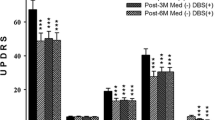Objective. To analyze pharmacotherapy on the background of stimulation of the subthalamic nucleus (STN). Materials and methods. A total of 54 patients with implanted STN stimulation systems (Medtronic) were investigated from 2003 to 2012. The severity of motor disorders, daily activity, and complications of pharmacotherapy were evaluated using parts II, III, and IV of the Unified Parkinson’s Disease Rating Scale (UDPRS) before surgery and at one, three, and four years of continuing stimulation. The equivalent daily dose of levodopa was evaluated, along with analysis of pharmacotherapy overall. Results and conclusions. The severity of motor impairments in off periods decreased by 52.3% by one year of observation and remained stable for three years (51.8%), after which there was a small increase in the severity of motor symptoms, though not to the pre-operative level. The severity of motor fluctuations and iatrogenic dyskinesia decreased by 64.9%, 70.7%, and 42.7% at the ends of years 1, 3, and 4, respectively. The levodopa equivalent dose showed the greatest decrease by one year (57.7%), with decreases by 52.4% and 38.2% at three and four years, respectively. During the first year, 16.7% of patients took no levodopa. The levodopa dose decreased by 64.6% at one year and then by 56.7% and 43.7% at three and four years, respectively. Dopaminergic receptor agonist monotherapy was used in 12.9% of patients, the proportion receiving agonists in combined therapy increasing from 24.1% to 35.2% during the post-operative period.
Similar content being viewed by others

References
A. A. Tomskii, E. V. Bril’, V. A. Shabalov, and N. V. Fedorov, “Electrical stimulation of the subthalamic nucleus in Parkinson’s disease,” Vopr. Neirokhir., No. 3, 14–17 (2006).
G. Kleiner-Fisman, J. Herzog, D. Fisman, et al., “Subthalamic nucleus deep brain stimulation: summary and meta-analysis of outcomes,” Mov. Disord., 21, Suppl. 14, 290–304 (2006).
J. Ferreira, R. Katzenschlagerb, B. Bloeme, et al., “Summary of the recommendations of the EFNS/MDS-ES review on therapeutic management of Parkinson’s disease. EFNS/MDS-ES GUIDELINES,” Eur. J. Neurol., 20, 5–15 (2013).
M. Aminoff, D. Boller, and D. Swaab, Handbook of Clinical Neurology, Elsevier (2013).
F. Weaver, K. Follett, M. Stern, et al., “Bilateral deep brain stimulation vs best medical therapy for patients with advanced Parkinson disease: a randomized controlled trial,” JAMA, 301, 63–73 (2009).
A. Williams, S. Gill, T. Varma, et al., “Deep brain stimulation plus best medical therapy versus best medical therapy alone for advanced Parkinson’s disease (PD SURG trial): a randomised, open-label trial,” Lancet Neurol., 9, 581–591 (2010).
G. Deuschl, C. Schade-Brittinger, P. Krack, et al., “A randomized trial of deep brain stimulation for Parkinson’s disease,” N. Engl. J. Med., 355, 896–908 (2006).
W. Schuepbach, J. Rau, K. Knudsen, et al., “Neurostimulation for Parkinson’s disease with early motor complications,” N. Engl. J. Med., 368, 610–622 (2013).
M. Okun, B. Gallo, G. Mandybur, et al., “Subthalamic deep brain stimulation with a constant-current device in Parkinson’s disease: an open-label randomised controlled trial,” Lancet Neurol., 11, 140–149 (2012).
J. Volkmann, C. Daniels, and K. Witt, “Neuropsychiatric effects of subthalamic neurostimulation in Parkinson disease,” Nat. Rev. Neurol., 6, 487–498 (2010).
J. Molinuevo, F. Valldeoriola, E. Tolosa, et al., “Levodopa withdrawal after bilateral subthalamic nucleus stimulation in advanced Parkinson disease,” Arch. Neurol., 57, No. 7, 983–988 (2000).
F. Valldeoriola, M. Pilleri, E. Tolosa, et al., “Bilateral subthalamic stimulation monotherapy in advanced Parkinson’s disease: Longterm follow-up of patients,” Mov. Disord., 17, No. 1, 125–132 (2002).
K. Østergaard, N. Sunde, and E. Dupont, “Effects of bilateral stimulation of the subthalamic nucleus in patients with severe Parkinson’s disease and motor fluctuations,” Mov. Disord., 17, 693–700 (2002).
M. Zibetti, M. Pesare, A. Cinquepalmi, et al., “Antiparkinsonian therapy modifications in PD patients after STN DBS: a retrospective observational analysis,” Parkinsonism Relat. Disord., 14, No. 8, 608–612 (2008).
M. Zibetti and A. Cinquepalmi, “Management of antiparkinsonian therapy during chronic subthalamic stimulation in Parkinson’s disease,” Parkinsonism Relat. Disord., 15, 76–80 (2009).
S. Thobois, S. Corvaisier, P. Mertens, et al., “The timing of antiparkinsonian treatment reduction after subthalamic nucleus stimulation,” Eur. Neurol., 49, 59–63 (2003).
W. Gibb and A. Lees, “The relevance of the Lewy body to the pathogenesis of idiopathic Parkinson’s disease,” J Neurol. Neurosurg. Psychiatry, 51, 745–752 (1988).
M. Hoehn and M. Yahr, “Parkinsonism: onset, progression and mortality,” Neurology, 17, No. 1, 27–42 (1967).
G. I. Defer, H. Widner, R. M. Marié, et al., “Core assessment program for surgical interventional therapies in Parkinson’s disease (CAPSIT-PD),” Mov. Disord., 14, 572–584 (1999).
E. Moro, M. Scerrati, L. M. Romito, et al., “Chronic subthalamic nucleus stimulation reduces medication requirements in Parkinson’s disease,” Neurology, 53, No. 1, 85–90 (1999).
J. L. Jaggi, A. Umemura, H. I. Hurtig, et al., “Bilateral stimulation of the subthalamic nucleus in Parkinson’s disease: surgical efficacy and prediction of outcome,” Stereotact. Funct. Neurosurg., 82, No. 2–3, 104–114 (2004).
G. Liang, “Medication adjustment after deep brain stimulation surgery of the subthalamic nucleus,” in: Deep Brain Stimulation for Parkinson’s Disease, M. Baltuch and M. Stern (2007).
M. S. Okun, T. Tagliati, M. Pourfar, et al., “Management of referred deep brain stimulation failures: a retrospective analysis from 2 movement disorders centers,” Arch. Neurol., 62, 1250–1255 (2005).
Author information
Authors and Affiliations
Corresponding author
Additional information
Translated from Zhurnal Nevrologii i Psikhiatrii imeni S. S. Korsakova, Vol. 115, No. 6, Iss. II, Neurology and Psychiatry in Elderly Patients, pp. 73–78, June, 2015.
Rights and permissions
About this article
Cite this article
Bril’, E.V., Tomskii, A.A., Gamaleya, A.A. et al. Pharmacotherapy on the Background of Electrical Stimulation of the Subthalamic Nucleus in Patients with Parkinson’s Disease. Neurosci Behav Physi 47, 275–280 (2017). https://doi.org/10.1007/s11055-017-0393-3
Published:
Issue Date:
DOI: https://doi.org/10.1007/s11055-017-0393-3



